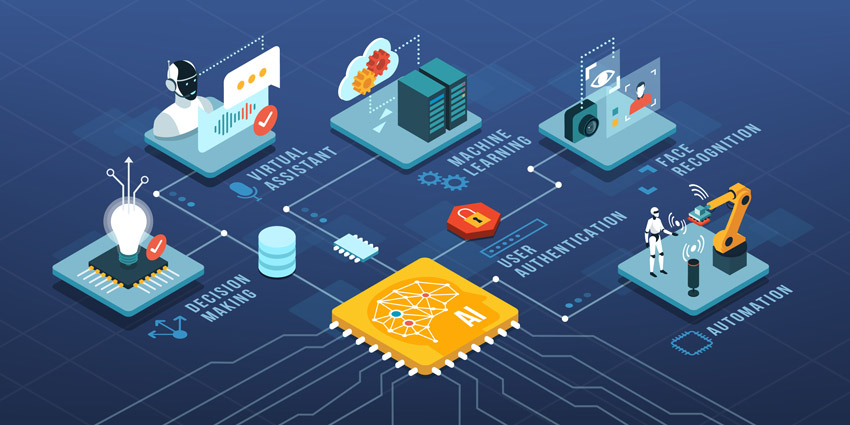Several technologies create Artificial Intelligence, which can sense, comprehend, act, and learn like humans. Because AI isn’t simply one thing, everyone’s concept of AI may be different.
Natural language processing and machine learning both fall under the umbrella of Artificial Intelligence. Each one is evolving in its way and may assist organizations in achieving their goals, whether it’s increasing customer service or optimizing the supply chain when used in conjunction with data, analytics, and automation. In the AI Program, you’ll learn the fundamentals and advanced artificial intelligence techniques, such as logic and knowledge representation, probabilistic models, machine learning, and probabilistic reasoning.
Definition of artificial Intelligence
Human-like qualities such as reasoning, learning, planning, and creativity can be displayed by a machine using Artificial Intelligence (AI).
Artificial Intelligence (AI) allows machines to sense their surroundings, deal with what they perceive, solve issues, and act to accomplish a specified goal. Computing devices such as a camera and other sensors such as microphones and cameras receive and process data before working on it.
Artificial intelligence (AI) systems can self-adaptation to a certain extent by analyzing the results of prior acts.
Artificial Vs. human Intelligence
So, what distinguishes artificial Intelligence (AI) from the human intellect? Humans invented Artificial Intelligence and the algorithms that enable it to function. While computers can learn from their surroundings and adapt or grow, humans construct them at the end of the day. Multitasking, memory, social interaction, and self-awareness are significantly more advanced in Human Intelligence. Artificial Intelligence lacks an IQ, making it distinct from human Intelligence. Automating multitasking or forming autonomous relationships is impossible. Machine learning and cognitive learning will never be the same thing. Artificial Intelligence (AI) can only match human Intelligence regarding speed and accuracy. A machine can’t teach itself human thought, no matter how smart it is or how many formulas you apply.
A brief explanation of how AI works
In other words, Artificial Intelligence (AI) is a discipline of computer science used to replicate human intellect in computer systems. Several hypotheses and definitions have emerged due to the general goal of artificial Intelligence: to make machines as intelligent as humans. Many people consider artificial Intelligence to be technology that can make machines intelligent. In a nutshell, “AI receives codes from the environment, and acts appropriately.”
According to the four components of artificial Intelligence, it works like
- Behaving Like a Human Being
- Acting in a Humane Manner
- The ability to reason
- Behaving rationally
The concepts of “thinking” and “acting” are closely linked to the mental processes of reasoning and processing, respectively.
Is there a way to explain how AI works?
To build an AI system, one must carefully reverse-engineer human characteristics and talents into a machine and then use that machine’s computing prowess to outperform humanity.
To comprehend how you might apply artificial Intelligence to diverse businesses, one must first grasp the multiple sub-domains of AI.
- Machine Learning (ML): Machine learning teaches a computer to draw conclusions and judgments based on previous experiences. It looks for patterns, analyses the last data, and concludes the current data without relying on human knowledge or experience. Businesses can save time and money by relying on automated data analysis to make better decisions.
- Deep Learning: ML uses a technology known as deep learning. Classifying, inferring, and forecasting the outcome of inputs instruct a computer to do so.
- Neural networks: Neural Networks are based on principles similar to human neural cells. Essentially, they are a collection of algorithms that mimic how a human brain processes information.
- Natural Language Processing (NLP): In NLP, a machine can read, comprehend, and interpret human language. Only when the system understands what the user intends to express that it replies appropriately.
- Computer vision: Computer vision algorithms attempt to decipher an image by dissecting and analyzing the many components of the items in the picture. Machine learning is aided by this, as it can better classify and learn from a collection of photos.
- Cognitive computing: Analysing text/speech/image/objects in a human-like manner and then attempting to produce the appropriate output is what cognitive computing algorithms are all about.
Future outcomes
AI in machines and computers is already widespread. It’s safe to believe that things will only get better. Future AI ideas frequently feature autonomous systems combining machine learning, cognitive skills, neural network involvement, and language processing.
Technically, General AI will be everywhere now, and its enhanced computational capacity will make the world run faster. For example, sarcasm can be understood by chatbots. Then it would endeavor to provide a service and answer that met or exceeded their expectations. It benefits the company.
Many people believe AI will replace human occupations with robots, creating new jobs dealing with and teaching machines. Jobs like data scientist, app developer, and social media director will become more common as AI advances.
Apps that track student progress and identify learning issues can assist teachers in knowing whom to help and how to aid without missing anyone.
Actual business value comes from AI:
Innovators have long looked to artificial Intelligence (AI). Now that the enablers are in place, enterprises can understand how AI can add value. Automation reduces costs and increases consistency, speed, and scalability of business operations; some Accenture clients save up to 70% in time. But the ability of AI to promote growth is more intriguing. Scaling companies get a 3X return on their AI efforts compared to those stuck in the pilot stage. So it’s no surprise that 84% of C-suite executives believe AI will help them develop.
Aside from these advantages, AI may harm justice, security, privacy, and safety. AI is a powerful force that can change the world, but it also has the potential to destroy it.
In summary
As previously stated, Artificial Intelligence is a set of technologies designed to reduce human labor. Despite recent progress, the AI industry still has a long way to go before creating fully-functional human-like machines that can accomplish everything in any circumstances.
